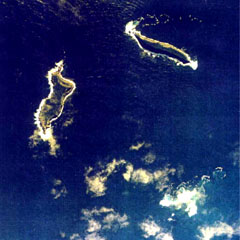Report on Hunga Tonga-Hunga Ha'apai (Tonga) — 15 December-21 December 2021
Smithsonian Institution / US Geological Survey
Weekly Volcanic Activity Report, 15 December-21 December 2021
Managing Editor: Sally Sennert.
Please cite this report as:
Global Volcanism Program, 2021. Report on Hunga Tonga-Hunga Ha'apai (Tonga) (Sennert, S, ed.). Weekly Volcanic Activity Report, 15 December-21 December 2021. Smithsonian Institution and US Geological Survey.
Hunga Tonga-Hunga Ha'apai
Tonga
20.5532°S, 175.3841°W; summit elev. 114 m
All times are local (unless otherwise noted)
According to a news article, Tonga’s head geologist reported that an eruption at Hunga Tonga-Hunga Ha'apai began at 0935 on 20 December. The eruption produced a steam-rich gas-and-ash plume that initially rose to 6 km (19,700 ft) a.s.l. by 0940, and then continued to ascend to 16 km (52,500 ft) a.s.l. and drift N. Lightning was present in the plume and about 9 kilotons of sulfur dioxide was detected in satellite data. Residents of Vava'u, 270 km NE, heard a series of explosions at a rate of several times per minute for the first 1-2 hours, after which they became sporadic. Explosions were heard through the night within the first 12 hours of the eruption. Ash emissions ceased at around 0200 on 21 December, though intermittent gas plumes with lightning continued at least through that day. Based on pilot observations, the Wellington VAAC noted that plumes rose 6.1-12.2 km (20,000-40,000 ft) a.s.l. and drifted N and NE on 21 December.
Geological Summary. The small andesitic islands of Hunga Tonga and Hunga Ha'apai are part of the western and northern remnants of the rim (~6 km diameter) of a largely submarine caldera located about 30 km SSE of Falcon Island. The topmost sequence of welded and unwelded ignimbrite units from a caldera-forming eruption was 14C dated to 1040-1180 CE (Cronin et al., 2017; Brenna et al. 2022). At least two additional welded pumice-rich ignimbrite units and nonwelded pyroclastic flow deposits, below paleosols and other volcaniclastic deposits, indicated more very large previous eruptions (Cronin et al., 2017; Brenna et al. 2022). Several submarine eruptions have occurred at this caldera system since the first recorded eruption in 1912, including 1937 and S of the islands in 1988. A short eruption in 2009 added land to to Hunga Ha'apai. At that time the two islands were each about 2 km long, displaying inward-facing sea cliffs with lava and tephra layers dipping gently away from the caldera. An eruption during December 2014-January 2015 was centered between the islands, and combined them into one larger structure. Major explosive eruptions in late 2021 initially reshaped the central part of the combined island before stronger activity in mid-January 2022 removed most of the 2014-15 material; an even larger eruption the next day sent an eruption plume high into the stratosphere, triggered shock waves through the atmosphere and tsunami across the Pacific Ocean, and left only small remnants of the islands above the ocean surface.
Sources: Matangi Tonga Online, Simon Carn, TROPOMI SO2, National Environmental Satellite, Data, and Information Service (NESDIS), Tonga Meteorological Services, Government of Tonga, Scott Bryan, Queensland University of Technology, personal comm, Wellington Volcanic Ash Advisory Center (VAAC)

